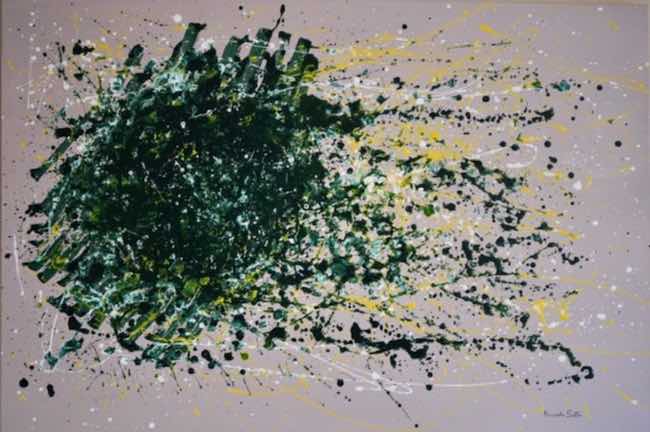Molto spesso l’arte, la manifestazione espressiva di qualcosa che vibra a livello interiore, diviene un processo esplorativo e catartico proprio perché il suo concretizzarsi è per molti artisti un atto istintivo in cui tutto viene lasciato al caso, all’impulso che guida la mano a farsi interprete delle emozioni trattenute e non ancora completamente emerse alla coscienza; in particolar modo l’approccio informale tende a lasciare all’autore dell’opera quella libertà istintuale attraverso cui la necessità di razionalizzare il sentire dà spazio alla pura e semplice esigenza comunicativa, senza guida, senza schema, solo con l’autonomia espressiva suggerita da quella stessa interiorità che desidera far sentire la propria voce. Il protagonista di oggi approda all’arte mescolando altre sue modalità percettive e sensoriali, come se l’incontro con la tela fosse la sublimazione e al contempo la sintesi di tutte le esperienze che appartengono alla sua vita.
Quando Jackson Pollock insieme ad Adolf Gottlieb, Marc Rothko, Hans Hofmann, William Baziotes e Franz Kline decisero di unirsi per dare origine a una nuova corrente pittorica che permettesse loro di essere riconosciuti come avanguardia artistica statunitense, non si focalizzarono su linee guida che avrebbero in qualche modo delimitato la loro esigenza di libertà creativa bensì scelsero di ergere a principale elemento distintivo quello dell’assoluta autonomia espressiva. L’Espressionismo Astratto, questo il nome del movimento fondato intorno agli inizi degli anni Cinquanta del Novecento, riuniva artisti eterogenei sia per stile pittorico che per impronta culturale poiché molti di loro si rifugiarono in America per sfuggire alle persecuzioni della seconda guerra mondiale; l’unica condizione per entrare nel gruppo era quella di infondere nelle tele le loro emozioni, le sensazioni altrimenti non manifestate, proprio per generare un distacco netto con l’Astrattismo, più rigoroso e freddo nei movimenti precedenti di inizio del secolo, recuperando dunque quella connessione con il soggetto creante per cui non solo il risultato ma persino l’atto stesso del dipingere diveniva forma comunicativa. L’Action Painting e il Dripping di Jackson Pollock erano tanto irruenti e impulsivi quanto invece riflessivo e contemplativo era l’approccio del Color Field che aveva contraddistinto le opere di Mark Rothko e di Barnett Newman, così come la poliedricità cromatica del Tachisme di Hans Hofmann poteva coesistere con la pittura segnica e prevalentemente bicroma di Franz Kline perché ciò che contava davvero era quella capacità di ciascuno di loro di generare una reazione emotiva in chi osservava le tele. Dunque le linee guida del movimento si proposero, peraltro con grande successo, di fondere due concetti differenti e apparentemente divergenti, almeno fino a poco prima: quello dell’Espressionismo che era pura emotività e che per dare la priorità alle sensazioni rinunciava a qualsiasi armonia formale, e quello dell’Astrattismo che al contrario puntava a distaccarsi da ogni immagine conosciuta per lasciare la priorità alla razionalità, alla purezza dell’arte fine a se stessa, senza che venisse contaminata dall’azione del soggetto. Con l’Espressionismo Astratto questi due estremi si unirono per dare vita a uno stile in cui la pura emozione, l’irrazionalità dell’impulso, di qualunque tipo esso fosse, poteva associarsi alla non forma che non era più un gesto artistico fine a se stesso bensì divenne un potente mezzo comunicativo. L’artista valdostano Riccardo Santin si avvicina all’espressione pittorica in maniera spontanea e curiosa, avvertendo l’esigenza di continuare la ricerca di sensazioni che lo accompagna nella sua carriera di sommelier e consulente gastronomico, dunque a contatto con percezioni più tattili e gustative, e quella di contemplazione attraverso la fotografia che da sempre lo appassiona inducendolo a cogliere il dettaglio, il particolare che lo conquista al punto di volerlo rendere protagonista.
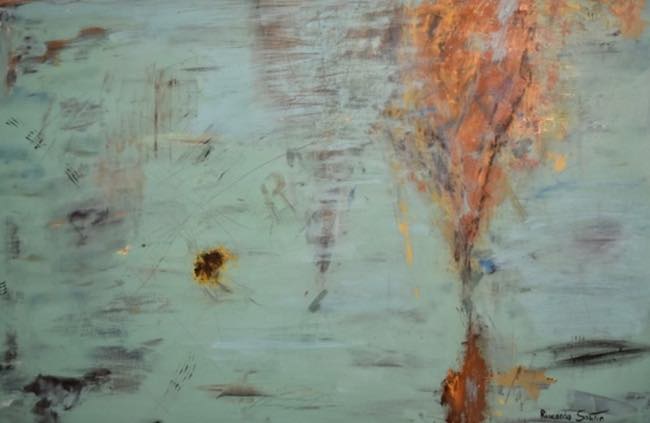
La pittura invece gli fa avvertire una libertà differente poiché nell’atto creativo diviene egli stesso primo attore di qualcosa che sul lavoro assaggia e negli scatti fotografici osserva, lasciandosi completamente andare all’istinto, alla pura emozione che sente fluire dalle profondità delle sue interiorità fino a materializzarsi sulla tela; è proprio questo il motivo della scelta dell’Espressionismo Astratto, uno stile che non impone, che non lega ad alcuno schema bensì gli permette di non sapere nulla fino al momento in cui sente di aver terminato la narrazione dell’attimo che desiderava comunicare, solo a quel punto si distanzia per osservare il prodotto della manifestazione spontanea del suo essere.
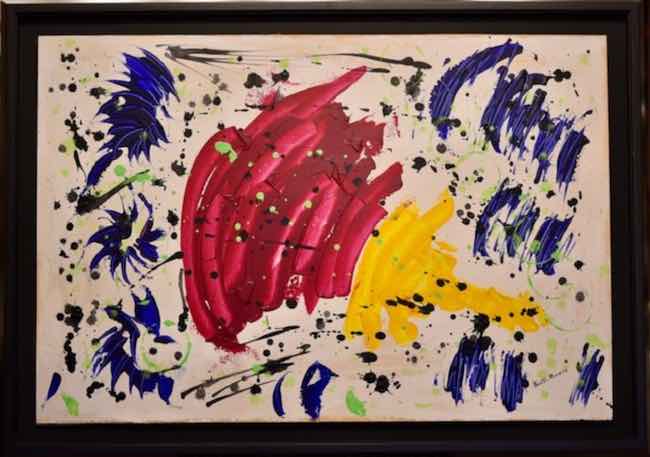
La pittura quindi diviene il completamento di una personalità che ha bisogno di misurarsi con differenti modalità di confronto con il sentire, con quell’attenzione verso il mondo sensoriale a cui non riesce a rinunciare e che contraddistingue l’intera vita di Riccardo Santin. Non solo, nell’atto artistico ha bisogno di sperimentare anche materiali inusuali ma che gli servono per rendere più incisivo quel mondo emozionale, la specifica sensazione a cui ha bisogno di dare voce, così ai colori acrilici mescola gli smalti industriali che stende non solo con il pennello bensì anche con le spatole e piccoli attrezzi da lui stesso costruiti e che vanno a coadiuvare il gesto impulsivo dell’Action Painting, lo ampliano e ne arricchiscono le potenzialità; le tonalità scelte sono spesso terrose, usa molto gli ocra, i terra bruciata, gli arancio forse per sottolineare quanto tutto ciò che viene avvertito, l’emozionalità che fuoriesce appartengono all’essere umano, al suo essere legato alla materialità della vita che ne costituisce le radici le quali pertanto contraddistinguono il suo passaggio nel mondo e da cui non riesce mai completamente a distaccarsi poiché è proprio la terra a nutrirlo.
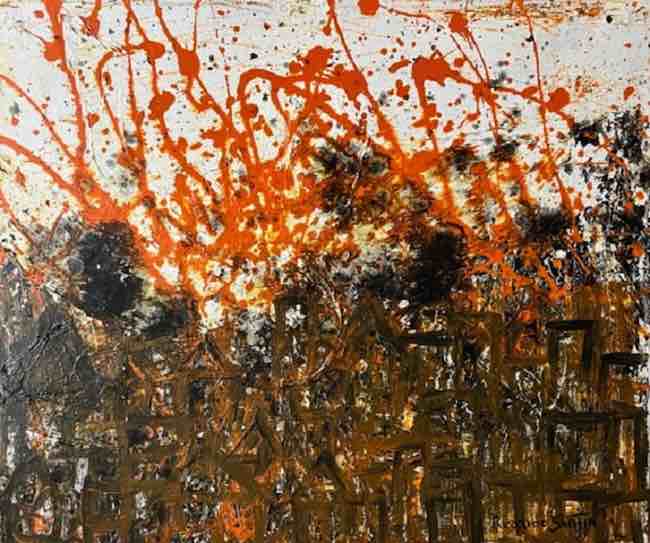
La soggettività si libera nell’atto comunicativo, nel suo caso nell’atto creativo, e assume la forma e il cromatismo che appartiene al soggetto e secondariamente all’emozione protagonista della tela. Dunque Riccardo Santin parla di sé, del suo essere in contatto con la natura, che contraddistingue la regione in cui vive, la Valle d’Aosta, e di tutto ciò che appartiene a un mondo interiore inconsapevole che emerge attraverso la pittura.
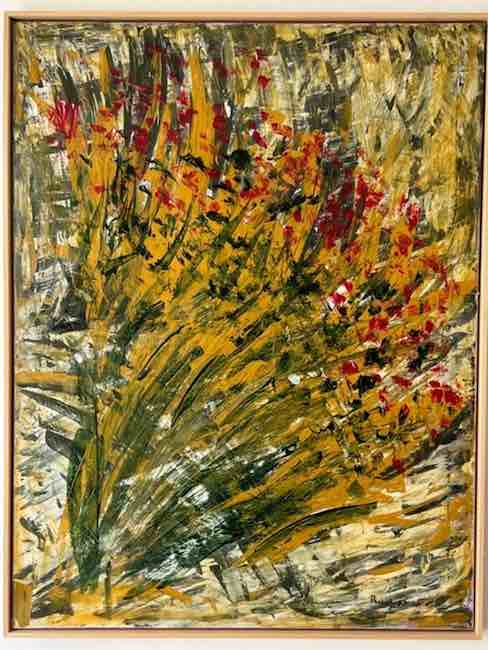
Nell’opera Fleurs de sable immortala una varietà di fiori della Camargue che letteralmente spuntano dalla sabbia e lo fa narrando la poesia che la sua interiorità ha percepito osservando un fenomeno naturale inusuale e per questo in grado di sorprendere il suo sguardo, lasciando che il suo ritmo emozionale respirasse l’armonia perfetta dell’immagine davanti a sé per poi porsi davanti alla tela e permettere all’emozione immagazzinata di fuoriuscire libera; i colori sono dunque sabbiosi, proprio per sottolineare la tonalità di base che circonda i fiori, mentre il rosso, appena accennato, racconta la vivacità che rompe l’equilibrio mono tono dello sfondo, come se lo sguardo di Santin fosse stato catturato più dall’armonia dell’insieme che dal singolo dettaglio.
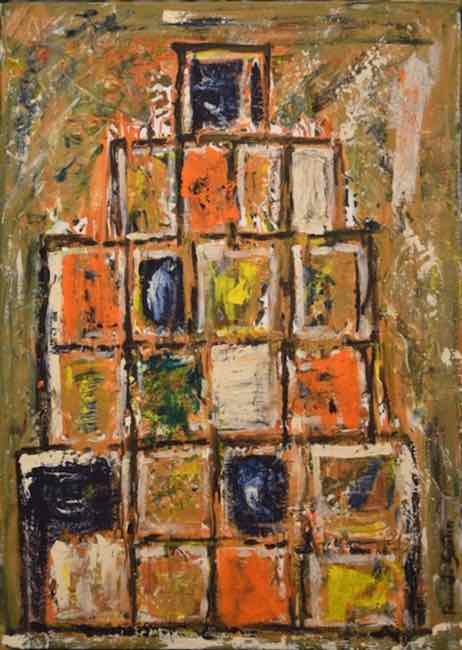
In La torre di Babele l’artista, riproducendo un episodio biblico, sottolinea e personalizza il messaggio che ne fuoriesce, quello cioè perfettamente attuale che l’eccessiva ambizione, la certezza arrogante di poter giungere a qualunque traguardo genera disgregazione, non solo del gruppo come nel caso del racconto della genesi, bensì anche del singolo poiché la prevaricazione, il desiderio di primeggiare, l’arrivismo a tutti i costi conducono inevitabilmente alla sconfitta, al precipitare clamorosamente verso il basso in quanto la mancanza di rispetto reciproco e di senso di comunità porta l’essere umano ad abbrutirsi al punto di restare solo, e solo non può riuscire a ottenere niente. Le celle rappresentanti le finestre verticali della torre, sono di colore diverso proprio per sottolineare la diversità che può divenire elemento disgregativo oppure associativo, tutto dipende dalla volontà del singolo.
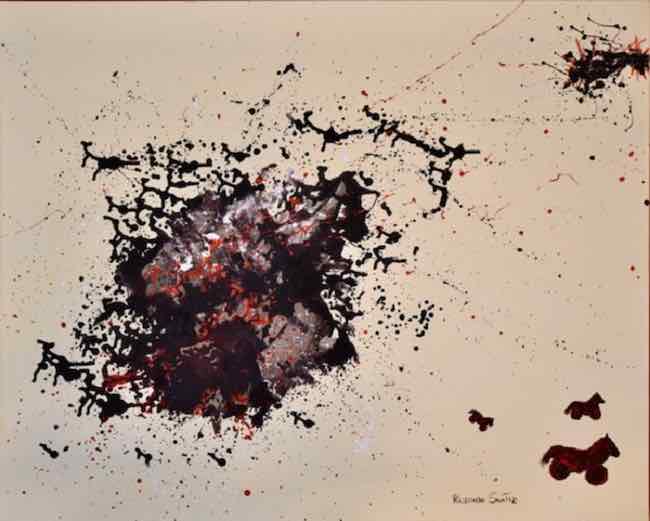
E ancora Il pianeta dei Tatà è il racconto di un mondo immaginato da Riccardo Santin, un universo magico dove nascono i cavallini di legno con le ruote, antichi giochi dei bambini valdostani denominati Tatà, e da cui escono per raggiungere il loro obiettivo finale, quello di rallegrare le giornate dei più piccoli; il bordeaux è uno dei colori che contraddistinguono alcuni Tatà ed è scelto dall’artista per costituire il nucleo magico che spicca sullo sfondo beige, quasi come se fosse proprio attraverso il contrasto che si potesse evidenziare la dimensione alchemica da cui poi fuoriusciranno i giocattoli che sembrano vivere di vita propria e scegliere verso quale bambino andare.
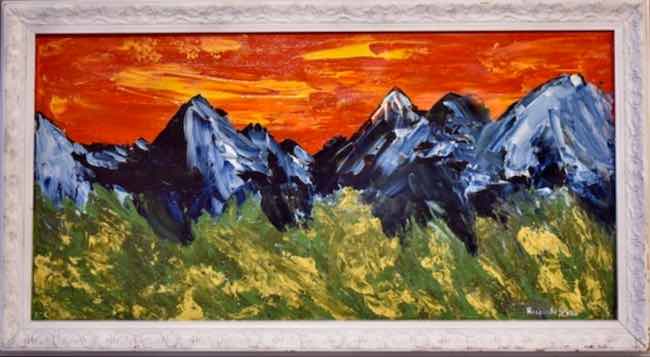
Riccardo Santin è iscritto all’Associazione Artisti Valdostani, partecipa a diverse mostre collettive e ha all’attivo un’importante esibizione personale.
RICCARDO SANTIN-CONTATTI
Email: riccardo.santin@gmail.com
Sito web: https://riccardosantin.blogspot.com
Facebook: https://www.facebook.com/riccardo.santin
Instagram: https://www.instagram.com/riccardo.santin/
The search for sensations that take shape on canvas in the Abstract Expressionism by Riccardo Santin
Very often art, the expressive manifestation of something that vibrates at an inner level, becomes an exploratory and cathartic process precisely because its concretisation is for many artists an instinctive act in which everything is left to chance, to the impulse that guides the hand to become the interpreter of emotions held back and not yet fully emerging to consciousness; in particular, the informal approach tends to leave the author of the artwork that instinctual freedom through which the need to rationalise feeling gives room for the pure and simple need to communicate, without guide, without scheme, only with the expressive autonomy suggested by that same interiority that wishes to make its voice heard. Today’s protagonist approaches art by mixing his other perceptive and sensorial modes, as if the encounter with the canvas were the sublimation and at the same time the synthesis of all the experiences that belong to his life.
When Jackson Pollock together with Adolf Gottlieb, Marc Rothko, Hans Hofmann, William Baziotes and Franz Kline decided to unite to give rise to a new pictorial current that would allow them to be recognised as the American artistic avant-garde, they did not focus on guidelines that would in some way delimit their need for creative freedom, but chose to make absolute expressive autonomy their main distinguishing feature. Abstract Expressionism, this is the name of the movement founded around the early 1950s, brought together artists who were heterogeneous both in painting style and cultural imprint since many of them took refuge in America to escape persecution during the Second World War; the only condition for joining the group was to infuse their emotions, sensations otherwise not manifested, into their canvases, precisely in order to generate a clear break with Abstractionism, which was more rigorous and cold in the previous movements at the beginning of the century, thus recovering that connection with the creating subject for which not only the result but even the very act of painting became a communicative form. Jackson Pollock’s Action Painting and Dripping were as impetuous and impulsive as the colour-field approach that had characterised the artworks of Mark Rothko and Barnett Newman was reflective and contemplative, just as the chromatic versatility of Hans Hofmann’s Tachisme could coexist with Franz Kline’s sign painting and predominantly bichromatic because what really mattered was that ability of each of them to generate an emotional reaction in the viewer of the canvas. Thus, the guidelines of the movement proposed, with great success, to merge two different and apparently divergent concepts, at least until recently: that of Expressionism, which was pure emotionalism and that, in order to prioritise sensations, renounced any formal harmony, and that of Abstractionism, which, on the contrary, aimed to detach itself from all known images in order to give priority to rationality, to the purity of art as an end in itself, without being contaminated by the action of the subject.
With Abstract Expressionism, these two extremes came together to give life to a style in which pure emotion, the irrationality of the impulse, whatever it was, could be associated with non-form, which was no longer an artistic gesture as an end in itself but became a powerful means of communication. The artist from Valle d’Aosta, Riccardo Santin, approached pictorial expression in a spontaneous and curious manner, feeling the need to continue the search for sensations that accompanies him in his career as a sommelier and gastronomic consultant, thus in contact with more tactile and gustatory perceptions, and that of contemplation through photography, which has always fascinated him, inducing him to capture the detail, the particular that conquers him to the point of wanting to make it the protagonist. Painting, on the other hand, gives him a different kind of freedom, since in the creative act he himself becomes the first actor of something that he tastes at work and observes in the photographs, letting himself completely go to instinct, to the pure emotion that he feels flowing from the depths of his interiority until it materialises on canvas; this is precisely the reason for his choice of Abstract Expressionism, a style that does not impose, that does not bind him to any scheme but rather allows him to know nothing until the moment he feels he has finished the narration of the moment he wished to communicate, only at that point does he distance himself to observe the product of the spontaneous manifestation of his being. Painting therefore becomes the completion of a personality that needs to measure itself with different ways of confronting feeling, with that attention to the sensory world that he cannot renounce and that characterises Riccardo Santin’s entire life. Not only that, in the artistic act he also needs to experiment with unusual materials that he needs to make more incisive that emotional world, the specific sensation to which he needs to give voice.
Thus, to acrylic colours he mixes industrial enamels that he spreads not only with a brush but also with spatulas and small tools that he himself has constructed and that assist the impulsive gesture of Action Painting, expand it and enrich its potential; the tones he chooses are often earthy, he uses a lot of ochres, burnt earth, oranges, perhaps to emphasise how much everything that is felt, the emotionality that escapes, belongs to the human being, to his being tied to the materiality of life that constitutes his roots, which therefore characterise his passage through the world and from which he can never completely detach himself because it is the earth that nourishes him. Subjectivity is set free in the communicative act, in his case in the creative act, and takes on the form and chromaticism that belongs to the subject and secondarily to the emotion that is the protagonist of the canvas. Thus, Riccardo Santin speaks of himself, of his being in contact with nature, which characterises the region where he lives, Valle d’Aosta, and of everything that belongs to an unconscious inner world that emerges through painting. In his artwork Fleurs de sable, he immortalises a variety of Camargue flowers that literally sprout from the sand, and he does so by narrating the poetry that his inner self has perceived while observing an unusual natural phenomenon and therefore capable of surprising his gaze, letting his emotional rhythm breathe in the perfect harmony of the image before him and then placing itself in front of the canvas and allowing the stored emotion to escape freely; the colours are therefore sandy, precisely to emphasise the basic tonality surrounding the flowers, while the red, barely hinted at, tells of the liveliness that breaks the mono tone balance of the background, as if Santin’s gaze had been captured more by the harmony of the whole than by the single detail.
In The Tower of Babel, the artist, by reproducing a biblical episode, emphasises and personalises the message that emerges from it, that is, the perfectly topical message that excessive ambition, the arrogant certainty of being able to reach any goal, generates disintegration, not only of the group as in the case of the Genesis story, but also of the individual, since prevarication, the desire to excel, and arrivism at all costs inevitably lead to defeat, to the clamorous plummet to the bottom, since the lack of mutual respect and of a sense of community leads the human being to brutalise himself to the point of being alone, and alone he cannot achieve anything. The cells representing the vertical windows of the tower are of different colours precisely to emphasise the diversity that can become a disruptive or associative element, all depending on the will of the individual. And again, The planet of Tatà is the story of a world imagined by Riccardo Santin, a magical universe where the wooden horses with wheels are born, ancient games played by children in Valle d’Aosta called Tatà, and from which they emerge to reach their final goal, that of brightening up the days of the little ones; burgundy is one of the colours that distinguish some of the Tatà and is chosen by the artist to form the magical nucleus that stands out against the beige background, almost as if it were through the contrast that the alchemic dimension from which the toys emerge, which seem to live a life of their own and choose which child to go to, could be highlighted. Riccardo Santin is a member of the Associazione Artisti Valdostani (Association of Aosta Valley Artists), participates in several group exhibitions and has a major solo exhibition to his credit.


